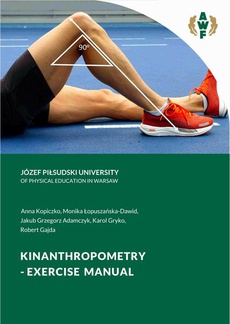POLECAMY

-20%
KINANTHROPOMETRY - EXERCISE MANUAL
Wydawca:
Format:
pdf, ibuk
Research studies on the morphological determinants of motor skills fall within the field of interest of a relatively young discipline termed kinan-thropometry. The name has its roots in the Greek words kinein (to move), anthropos (human), and metrein (to measure). The guide is an auxiliary material for conducting practical classes in the field of sport. The content of the guide is intended to show students what kinanthropometry is as a relatively new academic subject. Its purpose is to provide a set of refer-ence methods for kinanthropometric diagnostics. Measurements are usu-ally carried out using anthropometric methods and then used for analysis in the context of the effects of human movement activities.
The popularity of kinanthropometry is growing worldwide while it is used in many research areas, especially in physical culture and medical and health sciences. Kinanthropometry has applications in many fields includ-ing, for example, ergonomics, nutrition, healthcare, and injury prevention. Its goal is to gain a thorough understanding of the functioning of the hu-man body by measuring its size, shape, proportion, and tissue composi-tion in relation to health, physical activity, and motor performance. With the analysis of the relationship between morphological structure and mo-tor effects, kinanthropometry contributes significantly to optimizing the training of athletes by reducing the risk of injury and development of ap-propriate therapeutic strategies. Studies conducted in children provide additional opportunities to identify, in the early stages of human develop-ment, their sports potential, whereas simultaneous tracking of changes over time in groups of non-athletes and athletes makes it possible to de-termine the impact of early sports training on the course of development and maturation. The practical part of the guide is organized so that it will be useful for future coaching work, independent scientific research, and undergraduate, master's, or doctoral theses. In all content, emphasis is placed on tests, protocols and procedures, data collection, data analysis, and correct interpretation of results.
| Rok wydania | 2024 |
|---|---|
| Liczba stron | 144 |
| Kategoria | Sport |
| Wydawca | AWF Warszawa |
| ISBN-13 | 978-83-67228-26-8 |
| Numer wydania | 1 |
| Język publikacji | angielski |
| Informacja o sprzedawcy | ePWN sp. z o.o. |
Ciekawe propozycje
Spis treści
| INTRODUCTION | |
| 1. BODY MEASUREMENTS IN KINANTHROPOMETRY | |
| 1.1. Measurement instruments | |
| 1.2. Measurement technique in kinanthropometry | |
| 1.3. Somatometry in sport | |
| 1.4. Cephalometry in sport | |
| 1.5. Kinanthropometry in Adapted Sport | |
| 2. BODY INDICATORS AND INDICES IN SPORTS | |
| 2.1. Indices of physique, body proportions, and muscularity | |
| 2.2. Indices of general fatness and fat distribution | |
| 2.3. Fat-Free Mass Index (FFMI) and Fat Mass Index (FMI) | |
| 3. BODY COMPOSITION METHODS | |
| 3.1. Assessment of body composition based on somatic and body density measurements | |
| 3.2. Bioelectrical Impedance Analysis | |
| 3.3. Densitometry | |
| 4. FUNCTIONAL TESTING METHODOLOGY | |
| 4.1. Diagnostics of muscle dystonia, flexibility, mobility, and movement patterns | |
| 4.2. Anti-rotation and balance tests | |
| 4.3. Selective functional movement assessment | |
| 4.4. Measurements of range of motion: goniometry | |
| 5. EVALUATION OF SYMMETRY AND ASYMMETRY IN SPORTS | |
| 6. KINANTHROPOMETRY & EXERCISE PHYSIOLOGY | |
| 6.1. Heart rate monitors | |
| 6.2. Causes of artifacts on HRMs | |
| 6.3. Modern HRMs with ECG recording function and the procedure in case of detecting ,,arrhythmia" on HRM's | |
| 6.4. Interpretation of HR measurements in training and post-exercise recovery | |
| 6.5. Heart Rate Variability (HRV) | |
| 7. STATISTICAL METHODS IN KINANTHROPOMETRY | |
| 7.1. Preparation of data for statistical processing | |
| 7.2. Statistical analysis | |
| 7.3. Tabular and/or graphical representation of results | |
| REFERENCES | |
| ABOUT THE AUTHORS | |
























